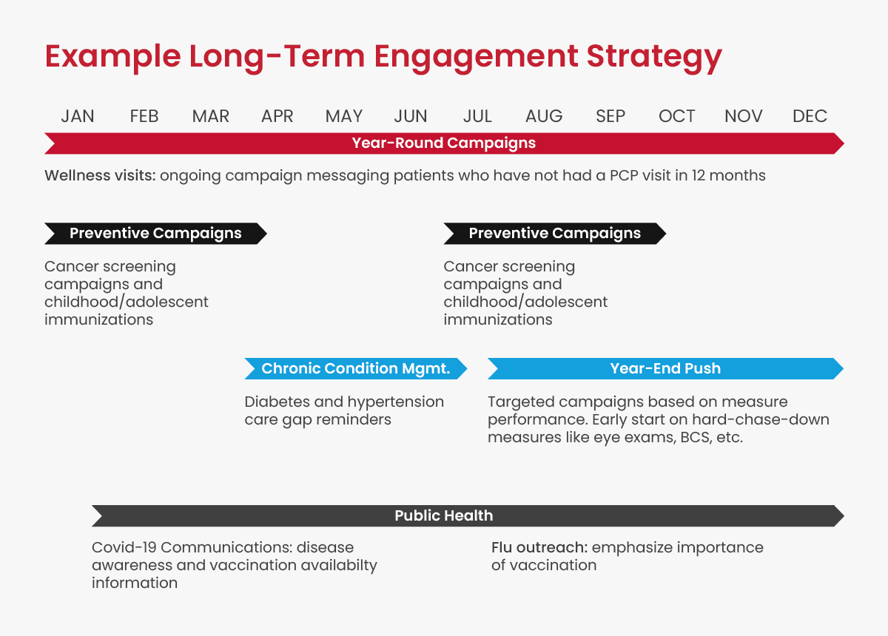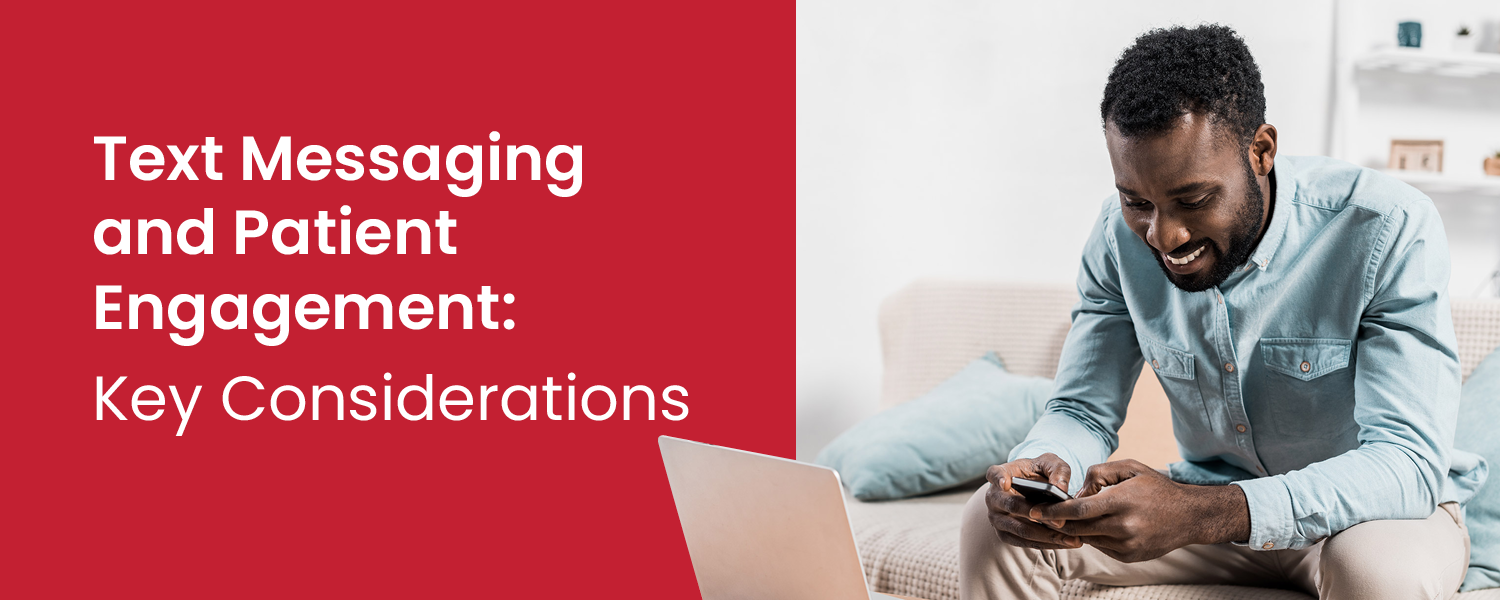To effectively reach and engage patients, healthcare organizations must take their habits and preferences into account. And in a more socially connected culture than ever before, these preferences are directly aligning with an upswing in text message communication.
One recent survey found that 98% of patients prefer to receive text messages over phone calls, and the number of texts sent per day seems to increase for each generation. Cell phone users aged 18-24 send an impressive 4,000 text messages per month.
So, how can healthcare organizations take advantage of this trend? And is it worth investing in long-term? In this guide, we’ll answer these questions and explore how your organization can use SMS messaging to effectively engage its diverse patient communities. Let’s begin.
Patient engagement benefits
Communicating personal health information requires timeliness and direct language. That’s why the immediacy and accessibility of text messaging make it a near unbeatable patient outreach and engagement tool. Not to mention, text messages have the highest open rates compared to any other form of communication (98%), so providers can feel more confident that their messages are getting through.
Some other factors that speak to the engagement benefits of text message outreach include:
- Patient segmentation features. Healthcare organizations can organize and target their patient populations with personalized messages based on predefined factors such as demographics, health conditions, and treatment plans.
- Cost and resource efficiency. Text messaging uses automation to decrease administrative burdens and free up more staff time. It’s also more likely to minimize costs related to missed appointments and readmissions.
- Content versatility. Short messages can be tailored to convey a variety of message types and include links to other information, such as in-depth videos and web-based healthcare resources for patients to find more information.
- Data tracking features. Healthcare organizations can warehouse the data they receive from texts to gain a better sense of their communities and get more detail on the challenges their patients face.
- Health equity promotion. For disproportionately underserved patient populations, text messaging can be a vital tool to promote health equity and break down socioeconomic accessibility barriers.
Because of these features, healthcare organizations are leaning into the power of text outreach to promote comprehensive, value-based care.
Text message automation
By implementing automation techniques as part of their marketing strategies, healthcare organizations can send out a variety of communications to efficiently connect with their patients. These include sharing information related to:
- Appointment reminders and scheduling.
- Prescription reminders.
- Waitlist notifications.
- General health tips and education.
- Survey and feedback requests.
- Preventative care and screening reminders.
- Billing and payment notifications.
- Emergency health alerts and updates.
More personalized, real-life examples of text message engagement could look like reminding a diabetic patient to check blood sugar levels or prompting an at-risk patient to schedule a preventative screening. These quick reminders can greatly improve health quality by nudging patients to take the next step in self-care management.
Compliance and privacy considerations
A common hesitation related to patient text message outreach is in regards to compliance and privacy concerns. Specifically, healthcare organizations must adhere to The Health Insurance Portability and Accountability Act (HIPAA), as the Telephone Consumer Privacy Act (TCPA) does not apply to appointment confirmations, lab results, reminders, or pre or post-operative instructions.
HIPAA exists to prevent disclosure of sensitive health information without patient knowledge or consent. This relates to a patient’s protected health information (PHI), sometimes referred to as e-PHI in electronic formats.
To access the engagement benefits of text outreach while ensuring your texts are HIPAA-complaint, follow these best practices:
- Obtain written consent from patients for you to communicate via text. Let them know what data will be shared and inform them of their responsibility to protect it.
- Use a secure, HIPAA-compliant SMS platform to encrypt messages and avoid accidental or ill-intentioned data leaks.
- Provide patients with an easy opt-out option if they no longer wish to receive notifications from your organization.
Once you receive consent, you need to also consider if the patient would like someone else to receive text messages on their behalf. If this is the case, you must secure explicit permission from the patient and the contact.
Patient response tracking
Once your organization starts sending patient text message outreach, you’ll need to know how to measure its effectiveness so you can adjust your strategy and maximize engagement. To give you an idea of what this could look like, here’s a framework you can use to track patient response rates:
- Set clear objectives. Define concrete goals related to your patient outreach, such as increasing appointment confirmations or improving medication adherence.
- Segment your patient populations. Divide your patients into segments, so you can measure clear metrics based on predefined characteristics. For example, older patients might have a different appointment confirmation rate than younger patients.
- Test for effectiveness. Dig into which texts performed best based on timing, content, frequency, and length. For example, you may find that engagement with appointment follow-up texts increases by X% if the text is sent one hour following the initial appointment.
- Adapt and improve your strategies. As you gather more feedback, adapt and improve your messaging to engage your patients in the most effective ways. For instance, you might gather survey feedback that suggests an increase in frequency.
You can go one step further by leveraging data analytics tools to conduct a deep dive into your patient population response rates to discover which messages hit the mark and finalize outreach strategies based on pre-defined populations. For example, features such as sentiment analysis and natural language processing capabilities can help you pinpoint which texts are the most effective at a glance.
Long-term engagement
Immediate patient engagement is helpful, but to lead to enhanced patient retention and healthier habits, it's best to consider outreach in terms of long-term engagement. This means healthcare organizations should structure their text message outreach campaigns in a timely manner that generates the highest ROI.
As an example, Arcadia’s year-round engagement strategy provides this approach:

By mapping out how many campaigns you plan to run ahead of time, your organization can conduct timely outreach. Campaigns to consider aligning with your calendar could include year-round, preventative, chronic condition management, and general public health campaigns. This way, you’re not bombarding recipients. Instead, you can take advantage of a data-backed cadence.
As with most industries, engagement and text message outreach go hand in hand. Healthcare organizations can utilize messaging as a way to build their patient relationships and inspire improved health outcomes.

